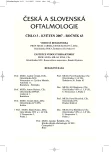The Intraocular Lens Dioptric Power Calculation after Refractive Procedures in Myopia
Authors:
M. Černák; A. Černák
Authors‘ workplace:
Očná klinika FNsP a SZU, Bratislava
prednosta prof. MUDr. A. Černák, DrSc.
Published in:
Čes. a slov. Oftal., 63, 2007, No. 3, p. 165-169
Overview
Aim:
To evaluate the efficiency of the intraocular lens (IOL) dioptric power calculation before the cataract surgery in patients after photorefractive keratectomia (PRK) in myopia.
Methods:
Six eyes of three patients were included in a prospective, non-randomized study. In all six eyes, the exact values of the preoperative corneal curvature, and in some of them, the exact value of the removed myopia were not available. The IOL power was calculated by means of formula, which is based on data not affected by the refractive surgery: axial length of the eyeball, depth of the anterior camber, and visual acuity for far corrected with glasses after the cataract surgery. The last value we can achieve not until after the surgery, so because of this reason, the surgery is divided into two stages. In stage one, the cataract is removed only, and on the next day, after the IOL power calculation, in the second stage, the IOL implantation is performed.
Results:
Three months after the cataract surgery, the refractive error was up to ± 1.0 diopter in all eyes, and the corrected as well as uncorrected visual acuity improved in every single eye.
Conclusion:
For patients, who previously underwent refractive procedure and no exact preoperative values are available, the method of two stages’ cataract surgery is method of choice. Disadvantage of this method is that the patients must go two times to the operation theatre; the advantage is very exact IOL power calculation and the patient’s satisfaction.
Key words:
myopia, refractive surgery, IOL power calculation
Labels
OphthalmologyArticle was published in
Czech and Slovak Ophthalmology

2007 Issue 3
Most read in this issue
- Ocular Manifestations in Turner’s Syndrome
- The Methods of Analysis of the Endothelial Microscopy
- Comparison of the Two Methods, LASIK and ICL in Mild and High Hyperopia Correction – Part One
- The Contribution of the Hematological Examination in Patients with Retinal Vein Occlusio
